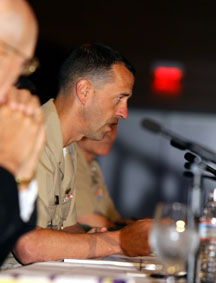What Challenges Does the Future Force Face?
Attempting to look into a crystal ball to determine the challenges future joint forces will face, Wednesday morning's panelists discussed changing threats, changing enemies and the ways the joint force will have to change to address them. One major change has been the U.S. shift from supremacy in the battlefield and national security to the quest for dominance in these areas. While supremacy is designed, dominance may be the best we can achieve and will be enough, the panelists agreed.
 Attempting to look into a crystal ball to determine the challenges future joint forces will face, Wednesday morning's panelists discussed changing threats, changing enemies and the ways the joint force will have to change to address them. One major change has been the U.S. shift from supremacy in the battlefield and national security to the quest for dominance in these areas. While supremacy is designed, dominance may be the best we can achieve and will be enough, the panelists agreed.
Addressing specifically the joint aspect of the future of warfighting, panelists concurred that the services must accept that each of them bring a different strength to the domain. What is needed is cross-domain dominance, which requires joint strategies.
In that vein, Rear Adm. John Richardson, USN, director for strategy and policy, J-5, JFCOM, revealed that the command revising its two key documents that outline future concepts for joint warfare in the future. The revisions are being conducted with input from the services as well as academia and to date illustrate the need for the force to be able to respond quickly to emerging threats.
Maj. Gen. Roy M. Worden, USAF, vice commander, ACC, pointed out that one of the challenges for the military in the future will be staying relevant and dominant. While technology is changing rapidly, the high cost and slow development and acquisition cycles will cause this challenge to grow, he said.
"It does take an effectively dominant force to avoid the war or support our national security efforts. It comes down to how do I focus on the future fight on capabilities? We need to focus on access and agility, balance across the spectrum of what goals capabilities serve and connectivity ... how does the soldier stay connected to bring about full force?" Gen. Worden said.
Listen to the complete panel session here (mp3 link):
Panel session: What Challenges Does the Future Joint Force Face?
Attempting to look into a crystal ball to determine the challenges future joint forces will face, Wednesday morning's panelists discussed changing threats, changing enemies and the ways the joint force will have to change to address them. One major change has been the U.S. shift from supremacy in the battlefield and national security to the quest for dominance in these areas. While supremacy is designed, dominance may be the best we can achieve and will be enough, the panelists agreed.
Addressing specifically the joint aspect of the future of warfighting, panelists concurred that the services must accept that each of them bring a different strength to the domain. What is needed is cross-domain dominance, which requires joint strategies.
In that vein, Rear Adm. John Richardson, USN, director for strategy and policy, J-5, JFCOM, revealed that the command revising its two key documents that outline future concepts for joint warfare in the future. The revisions are being conducted with input from the services as well as academia and to date illustrate the need for the force to be able to respond quickly to emerging threats.
Maj. Gen. Roy M. Worden, USAF, vice commander, ACC, pointed out that one of the challenges for the military in the future will be staying relevant and dominant. While technology is changing rapidly, the high cost and slow development and acquisition cycles will cause this challenge to grow, he said.
"It does take an effectively dominant force to avoid the war or support our national security efforts. It comes down to how do I focus on the future fight on capabilities? We need to focus on access and agility, balance across the spectrum of what goals capabilities serve and connectivity ... how does the soldier stay connected to bring about full force?" Gen. Worden said.
Listen to the complete panel session here (mp3 link):
Panel session: What Challenges Does the Future Joint Force Face?



Comments